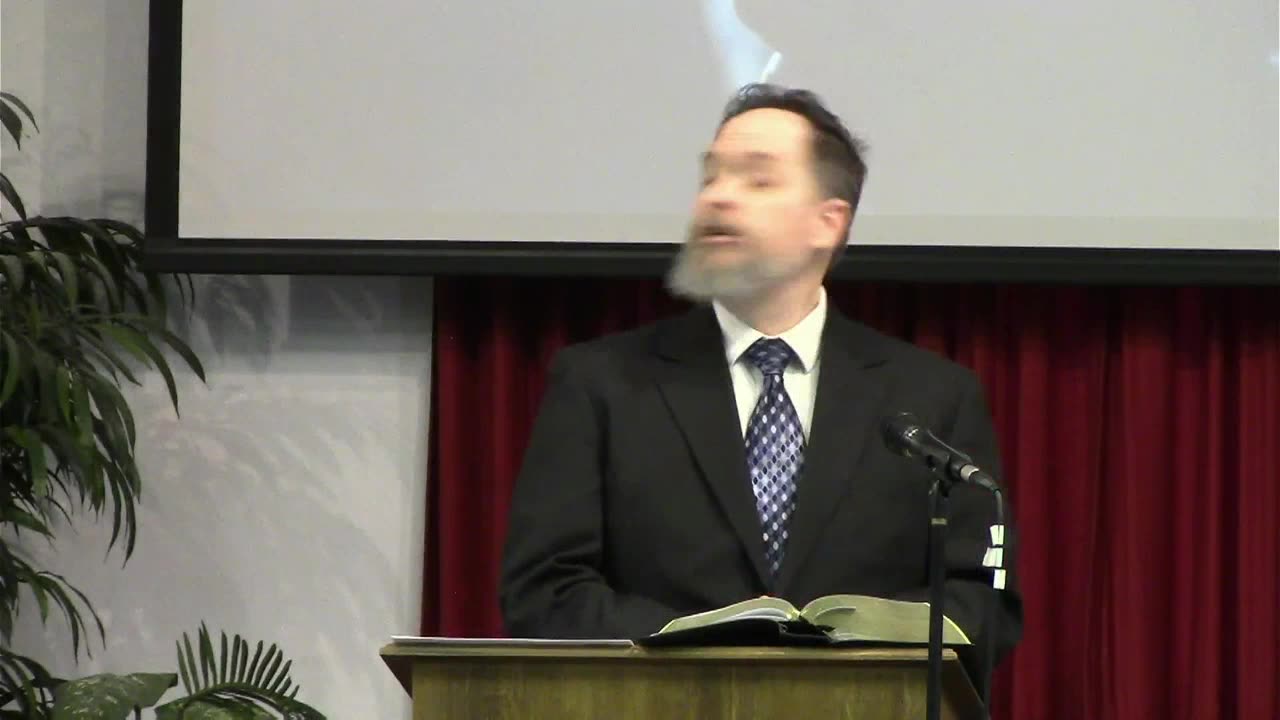Premium Only Content

How Should We Worship Together? (Acts 2:41–42)
Some churches make spontaneity the aim of their services to give a sense that something truly authentic is happening, but others have set orders of worship. Would the Holy Spirit call us to have a liturgy?
-Notes: https://pastormarksbury.blogspot.com/2025/02/sermon-how-should-we-worship-together.html
-Livestream: https://lwbcfruita.org/live
-Donations: https://www.lwbcfruita.org/give
Manuscript:
How Should We Worship Together? (Acts 2:41–42)
Series: Questioning the Church #5
Text: Acts 2:41–42
By: Shaun Marksbury
Date: February 9, 2025
Venue: Living Water Baptist Church
Occasion: AM Service
I. Introduction
The Anglicans and the Baptist preacher, Charles Spurgeon, sometimes had some interesting interactions. Since Baptist churches were not part of the Church of England, no one could admit to liking him. It is said that once, even Queen Victoria came in disguise to hear the Prince of Preachers.
Spurgeon had some words over the years about how the Anglicans conducted their worship services, but that didn’t stop church clergy from borrowing from Spurgeon’s material. In fact, there was a limerick going around Anglican churches:
There was a young man named Spurgey
Who didn’t like our liturgy
But his sermons were fine
So I make them mine
And so do the rest of the clergy.
We’re returning to our “Questioning the Church” series, and to do so, we’re talking about a word that makes many Evangelicals uncomfortable: liturgy. Many, even today in Baptist churches, have a visceral reaction to anything that seems too liturgical. And this is sometimes for good reason, because many have noticed, like Spurgeon, that additions have crept into Christian worship service, mysterious elements built more upon tradition than upon the teaching of Holy Scripture.
Other churches might express other reasons. They might make spontaneity the aim of their services to give a sense that something truly authentic is happening. They might have no clue what might happen during the worship hour on any given Sunday, opening for anyone to be a preacher or to lead a song. Interestingly, other church plan for “spontaneous” moments. While this may give the sense that there’s room for the Holy Spirit on paper, some have learned through experience other spirits might also fill that time.
If you use the word “liturgy” as a pejorative, you really shouldn’t, though. At its base definition, a liturgy is merely an order of service. It can be a complicated liturgy with smells and bells, or it can be a simple one. So, the truth is that we all have liturgies, even if it’s a plan to sit in silence and watch what happens. Sure, we don’t conduct ourselves quite like some high churches do, but a prayer, three songs, and a sermon is an example of a liturgy.
Would the Holy Spirit call us to have a liturgy? That brings us to our Spirit-inspired passage today. We don’t want to find ourselves adding our own traditions to the worship of the Lord, and we certainly don’t want to miss something that the Lord would have us include.
In the early days of the church, we see a pattern to follow. For instance, Scripture reveals that Christians began meeting on the first day of the week or the Lord’s Day, and according to second-century writers, Sunday worship was the norm for Christians. Because Jesus had risen from the dead on Sunday, the church quickly settled into Sunday worship.
We also see the particulars of Christian worship in the text we’ve read, elements that marked the early church at the day of its birth. As we consider what a church should incorporate in its worship service, we see the importance here for baptism, Scripture, fellowship, communion, and prayer. Let’s consider what the Lord instituted together.
II. First, Church Worship Should Include Baptism (v. 41)
So then, those who had received his word were baptized; and that day there were added about three thousand souls.
This verse comes on the tail of Peter’s sermon exalting Christ. You’ll remember that the people responded with the question, “Brethren, what shall we do?” (v. 37). Peter then proceeded to tell them essentially how to become Christians — repent, turn and trust in the Lord Jesus Christ as the Savior. Then, follow in obedience, becoming baptized as a testimony of the forgiveness of sins.
Well, the Holy Spirit was active that day. The crowds gathered because of His sound and the wonder of the disciples speaking in the tongues of the crowd. As Peter delivered this message, He delivered that great revival on Pentecost, resulting in three thousand receiving the Word and coming to Christ.
Now, of course, that they “received the word” has two different perspectives. On the one side, we have human responsibility. All those hearing the call to repent and don’t will be held accountable on the day of judgment.
On the other hand, we recognize that human depravity is such that man will always resist the gospel call, so the Lord must create a new heart within the believers. We notice the passive voice here — “that day there were added.” That thought repeats in v. 47, where we read that “the Lord was adding to their number day by day those who were being saved.”
The Lord is growing the church. We must remember the sovereignty of God in evangelism and church growth. Sometimes, He will allow a missionary to minister for a while without seeing any visible fruit, and churches may contract and not experience growth. At other times, there will be a seeming explosion in growth. He will do this for His glory; He says in Matthew 16:18, “I will build My church,” and we must trust Him for the fruit.
Now, we’re going to talk more about church membership later in this series, but it’s worth noting that the disciples noted those who came to Christ. As we’ll see later in this chapter, these converts remained in Jerusalem, so many began selling property to support the needs of those who might not have the means. The disciples were going from house to house (v. 46) because the crowd was likely too large to have consistent meetings otherwise. They were keeping track of members.
For our purposes today, note they baptized converts who received the Word, counting them. Believer’s baptism was practiced by the early church, obeying our Lord’s Great Commission (Matt. 28:19). However, this also includes the concept of making disciples, i. e., those old enough to decide to follow Christ. Moreover, as the Greek word from which we get baptize literally means “to dip,” and we always see converts in Scripture going into the water, it seems that anything else is simply tradition to be shed. Baptism is meant simply to point us back to the work that Christ has accomplished on our behalf through His death, burial, and resurrection.
Archeology has uncovered the large accommodations unearthed around the temple mount which Peter and the others could have used to baptize so many. Moreover, early church baptistries were often large, obviously constructed to immerse an entire person. While some started baptizing babies a bit later, the original mode was immersing believers soon after their professed conversions — the same day, in fact!
So, we rightly think of baptisms as part of worship, and since baptism was part of disciple-making, it’s linked to church membership. Unfortunately, churches treat this ordinance flippantly. Concerning baptism, sometimes we see big stage productions with pastors dunking people excessively hard and jerking them back up, all the while yelling like it’s a football game. There was a kerfuffle a few years back at Elevation Church under Steven Furtick; it was advertising “spontaneous baptisms,” people coming forward unexpectedly to receive baptism, and internal documents revealed that these were plants in the audience to emotionally manipulate others to come forward and do the same.
While nothing mystical is happening in water baptism, it is a visible reminder of the baptism in the Spirit, of the salvation of the soul. A person is also not only testifying to personal belief in Jesus, he’s also publicly identifying with the local congregation. It should bear some reverence in the local church, then! That’s why we often place it with our worship services when there are baptisms.
What does a disciple do once baptized? He should learn the Word of Christ. That brings us to the next point:
III. Second, Church Worship Should Include Scripture (v. 42a)
They were continually devoting themselves to the apostles’ teaching
Consider again the Great Commission. Jesus’s words in Matthew 28:18–20 are, “All authority has been given to Me in heaven and on earth. Go therefore and make disciples of all the nations, baptizing them in the name of the Father and the Son and the Holy Spirit, teaching them to observe all that I commanded you; and lo, I am with you always, even to the end of the age.” The command is to make disciples or learners.
Of course, we already saw a bit of that command obeyed in v. 41, didn’t we? The disciples were making new disciples, and that was demonstrated through their willingness to be baptized. These new disciples also needed teaching, so we read about their commitment to it here. And, since the apostles were teaching about Christ, they were fulfilling the Great Commission.
Now, it starts with the devotion of the 3,000 new converts. They were devoted just like the apostolic disciples were (Acts 1:14). That they continually meet means that this was a regular and systematic practice — v. 46 says “day by day.” These days, we’re happy just to get people to come to church once a week!
They were serious about being disciples. That’s further evidence of the work of the Holy Spirit. Jesus said in John 8:31, “If you continue in My word, then you are truly disciples of Mine,” and these new converts were proving themselves to be just that.
Churches that don’t preach the Bible don’t preach about Jesus and the apostles’ teaching. Some might open the Bible, but they then teach life lessons or little pick-me-ups. They have doctrine — make no mistake — but it’s the doctrine of man.
Churches should teach the Bible, and all of it. The (in)famous Georgia pastor, Andy Stanley, got into hot water a few years back when he said Christians need to unhitch from the Old Testament. Well, the apostles would have taught the Old Testament as much as Jesus did. When Jesus was on the road to Emmaus, “beginning with Moses and with all the prophets, He explained to them the things concerning Himself in all the Scriptures” (Luke 24:27). So, the apostles would have taught it, and so should we.
Paul tells Timothy in 1 Timothy 4:13, “Until I come, give attention to the public reading of Scripture, to exhortation and teaching.” It was Timothy’s job as a pastor to lead the church in this. We considered this in 2 Timothy 4:1–2, where he says, “I solemnly charge you … preach the word; be ready in season and out of season; reprove, rebuke, exhort, with great patience and instruction.” Preaching and teaching of Scripture must be a part of worship.
In teaching Scripture, we develop sound doctrine. God’s people need godly theology. And they need something else:
IV. Third, Church Worship Should Include the Fellowship (v. 42b)
and to fellowship,
They were dedicated to the fellowship of the saints. This doesn’t necessarily mean what we make of it today, such as “doing life together.” They were together, but fellowship implies a commitment to one another. Why do I say that?
The word, koinonia, speaks of a partnership as well as a sharing. We see this literally played out in the following verses. Whenever a Christian had a need in Jerusalem, someone with money would meet that need. They were so generous that we read none had any needs. This is why the early church developed the practice of weekly collections; Christians showed their brotherhood through whatever financial support they could.
You might ask if giving is an act of worship, and of course it is! We see in Scripture the practice of gathering money once a week, and it is linked to personal worship. As 2 Corinthians 9:7 says, “Each one must do just as he has purposed in his heart, not grudgingly or under compulsion, for God loves a cheerful giver.” Churches shouldn’t coerce people into giving, but it should arise out of a sense of joy and thanksgiving to the Lord.
Now, of course, the koinonia or sharing meant more than simple financial giving. As the New American Commentary notes here of “fellowship,” “In secular Greek it could involve the sharing of goods, and Paul seems to have used it this way in 2 Cor 9:13. It was also used of communion with a god, especially in the context of a sacred meal; and Paul used it in that sense in 1 Cor 10:16.”[1] The commentary goes on to note that’s how it seems to be used here, appositionally with the breaking of bread and prayer.
That means that, as the church meets together, eating and praying, that was also Christian fellowship. We tend to think of fellowship only as something happening outside the church walls, or outside the corporate worship services. Perhaps it happens in at-home Bible studies or in retreats, or as we watch a football game together. However, we see that fellowship happens every Sunday morning, in the service. Again, that’s why it’s so important that we meet together.
Find a church that takes its Sunday morning and evening worship seriously, and you find a church that’s taking its fellowship seriously. That doesn’t mean that should be the extent of fellowship, as the next part of the verse implies. Let’s consider that next.
V. Fourth, Church Worship Should Include the Communion (v. 42c)
to the breaking of bread
This could be considered part of the fellowship (there’s no conjunction here). So, the first thing we should say about the breaking of bread was that the early church seems to have often enjoyed a common meal known as agape feasts. They gathered with food and wine to build more community around the table. Of course, it didn’t always work that way — Paul had to get onto some of the Corinthians for hoarding portions of the meal, not sharing, and becoming gluttonous and even drunken at the agape feasts. While that obviously went against the Spirit of the Lord, we know that great fellowship happens around the breaking of bread. That’s why so many churches have meals together. It’s an ideal that transcends culture and is quite biblical!
Still, that’s not all that was happening with the breaking of bread. The love feasts usually started with communion, or the Lord’s table. Along with baptism, this ordinance of our Lord is an essential part of worship. Jesus instituted His Supper as a remembrance of His death (Matt. 26:26-28; 1 Cor. 11:23-26). As the Heidelberg catechism puts it, “as certainly as I see with my eyes, the bread of the Lord broken for me, and the cup communicated to me; and… as assuredly as I receive from the hands of the minister, and taste with my mouth the bread and cup of the Lord, as certain signs of the body and blood of Christ.”[2] The bread and cup serve as another tangible reminder of the gospel.
The bread and the wine of the Lord’s Supper is a “sharing of the body of Christ” (1 Cor. 10:16). Verse 46 here says they were doing this “day by day,” but by Acts 20:7, it becomes once a week. During the Medieval Period of the church, the meal dropped back to only a yearly observance, and the priests kept the cup from the people. During the Reformation, it became quarterly and then, in some areas, monthly, and some even weekly. A proper observance would be to balance reverence with frequency — it shouldn’t be withheld for long periods of time, but it also should be something that invites reflection.
Unfortunately, churches also treat this ordinance flippantly. After the death of Travon Martin in Florida, one church offered skittles and sweet tea to underscore a political message rather than remember the death of our Lord. Since some churches chose to remain closed during the COVID scare, pastors have encouraged their people through live streams to use whatever they have at home by themselves for the bread and wine, even if it’s a Cheese-It and Mountain Dew. There’s no holiness or communion in such a practice.
So, join a church that will take the ordinances seriously. Finally:
VI. Fifth, Church Worship Should Include Prayer (v. 42d)
and to prayer.
The literal rendering here is “to the prayers,” which are essential for the worship service as well as in individual lives. Obviously, Christians should give themselves to pray continually, but so should the church. It’s important for the congregation to pray together on issues, as that builds fellowship. Moreover, it’s important for the people to hear their pastor praying for them.
Churches will typically pray. What we see, though, sadly, is that prayer isn’t a priority. We’re seeing fewer prayer services and the prayers in services have grown fewer. Sometimes, it seems like prayer only serves as a convenient buffer so the church crew can reset the stage, transitioning from the band to the pastor and then back again. It doesn’t seem like it’s an important enterprise, and some of you may have found yourself slipping out services on the final prayer so you can avoid the traffic.
We try to make prayer a priority. On Sunday evenings, we have a prayer of confession, as well as one of blessing. On Sunday mornings, we have a pastoral prayer that incorporates both elements as we pray for the whole church. We also offer up praises, as v. 47 says. Prayer is a precious and sweet time when we know the Holy Spirit is active in the life of the church.
VII. Conclusion
You might ask, what about music? Isn’t singing a part of worship? Of course it is, and we’ll focus on that next week. Until then, the LBC 1689 defines worship in this way, “The reading of the Scriptures, preaching, and hearing the Word of God, teaching and admonishing one another in psalms, hymns, and spiritual songs, singing with grace in our hearts to the Lord; as also the administration of baptism, and the Lord's supper, are all parts of religious worship of God” (22:5).
This is what church life led by the Holy Spirit looks like. There should be people who are saved, baptized, and gathered together. They devote themselves to Scripture. They fellowship, breaking bread together and praying. Folks, it’s that simple.
[1] John B. Polhill, Acts, The New American Commentary, (Nashville: Broadman & Holman Publishers, 1992), 26:119.
[2] Historic Creeds and Confessions, electronic ed. (Oak Harbor: Lexham Press, 1997).
-
 4:15:00
4:15:00
Nerdrotic
17 hours ago $50.87 earnedCaptain Falcon America REVIEW, Disney Ending DEI? Rings of Power RETURNS | Friday Night Tights #341
220K38 -
 9:34:03
9:34:03
FusedAegisTV
1 day agoMario Galaxy, Batman, Real Talk/Politics, & MORE - V-Day 💗 Friday Variety Stream!
64.6K1 -
 1:10:49
1:10:49
Vigilant News Network
13 hours agoRFK Jr. Drops a Stunning Announcement | The Daily Dose
83.8K45 -
 49:49
49:49
Candace Show Podcast
16 hours agoEXCLUSIVE: Blake & Ryan’s Desperate Legal Strategy Exposed! | Candace Ep 147
196K140 -
 1:32:20
1:32:20
2 MIKES LIVE
13 hours ago2 MIKES LIVE #180 with guest Kyle Rittenhouse!
56.5K4 -
 9:40
9:40
Tactical Advisor
18 hours agoBest Home Defense Shotgun Build | Genesis Gen 12
50.3K4 -
 56:44
56:44
VSiNLive
15 hours ago $4.42 earnedFollow the Money with Mitch Moss & Pauly Howard | Hour 1
74.3K1 -
 1:05:48
1:05:48
The Amber May Show
18 hours ago $3.67 earnedBig Balls | You Know It's Bad When Legacy Media Reports On Big Balls | Sam Anthony
43.3K7 -
 LIVE
LIVE
SoniCentric
1 day agoEnjoy a COZY Valentine's Day Escape to Paris with the BEST blend of Romantic Music
164 watching -
 1:59:52
1:59:52
Revenge of the Cis
16 hours agoEpisode 1447: Love Train
64.2K8